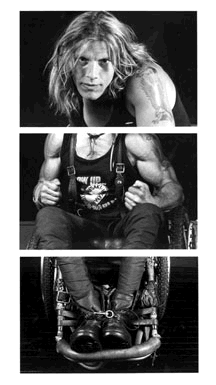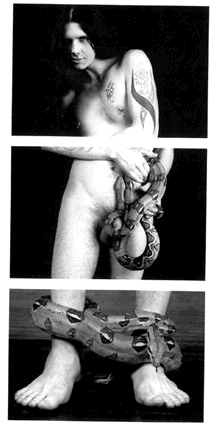Far outside the ivory tower,
Montreal police raid Sexgarage,
July 16, 1990.
Photo: ©Linda Dawn Hammond 1990
(Excerpt)
One of the most pressing issues in contemporary cultural criticism concerns the relationship between academic theory and the creation of art. This issue is hardly new, as even a cursory reading of the Frankfurt School or Walter Benjamin would indicate. Nevertheless, the connections between theory and culture are particularly important at this historical moment, with the advent of postmodern criticism . Many people charge that postmodern theory is fundamentally disconnected from the social world it describes. I
Postmodernism challenges the assumptions of the social world and the subjects within it. Whereas the philosopher Rene Descartes established human conciousness as the centre of all philosophical activities ("I think. Therefore I am ), post-modernism argues quite the opposite: all-knowing subjects who are in control of their thoughts, beliefs and actions are, at best, a historical invention. Postmodernism contends that we now live in a world saturated hy media images, such that absolute knowledge of oneself is impossible. Jean Baudrillard takes this position to its extreme, declaring that "reality" as such does not exist: all we have are images. In one famous example, Baudrillard states that Disneyland presents itself as "fantasy" in order to convince people that the rest of America is "real."2 For Baudrillard, Disneyland is neither real nor false, bur is rather a site that conceals the fiction of the real. All of America is plastic&emdash; hyperreal. Since media images saturate everything (including one's understanding of the social world), Baudrillard maintains that we must abandon the Marxist notion of ideology (which still makes recourse to some "reality") and look instead to the realm of seduction.The social is dead. Postmodernism also emphasizes that images can be reproduced in contexts other than those in which they originally appeared. "Reality" as such does not exist; it is always mediated.
Critics of postmodernism do not dispute the notion that reality is socially constructed. But they do worry about the ways in which postmodern theory tends to focus exclusively on issues of aesthetics and form. A restricted emphasis on images and rhetoric, they argue, results in criticism that is disengaged from its social relations. Questions of history, community and cultural context are ignored in favour of abstract concepts like simulation and seduction.
Arthur Kroker's combination book/CD Spasm: Virtual Reality, Android Music and Electric Flesh (1993) provides an opportunity to reflect on some of the methodological, and political, issues raised hy critics of postmodemism. Spasm
P.56

"Charlie", 1990, from Three Part Bodyseries
Photo: ©Linda Dawn Hammond 1990
centers on three contemporary artists: David Therrien, whose art deals with the impact of technology; Linda Dawn Hammond, a photographer who documents piercing, fetishist and queer communities, and Steve Gibson, a musician whose work involves digital technology and "sampling," techniques, and who wrote and coproduced much of the music on the accompanying compact disc. For Kroker, these three artists are significant because they all work in the margins.
In Spasm, which continues the project initiated in his other writings, Kroker examines cultural production that defies easy classification. He draws thc reader's attention to ways in which images can be recontextualized and reinscribed, such as the "sampling" practices of various artists, or the creation of "recombinant photographs." Although his project is deeply indebted to Baudrillard, Kroker takes issue with the French theorist on the question of simulation and the referent. Whereas Baudrillard argues that there is only simulation, Kroker suggests that the issues are more complex. In his view,
We no longer live in the age of simulation, but of recombinant culture. That point where the model of simulation severs its relationship with the social, undergoing a fateful merger with the language of genetics. A world of bio power where technology becomes flesh.3
Insofar as Kroker acknowledges the role and function of the real, he responds to the common complaint that Baudrillard's theory evacuates politics entirely. Kroker thus sets himself up as one of the few intellectuals capable of straddling this gap between high (French) theory and political intervention, hetween simulation and reality.
While Kroker does seem to part ways with Baudrillard by admitting that some kind of real world exists, he is less adept at situating the bodies, subjects and techno-
P.58

"Pierre", 1991, from Three Part Bodyseries
Photo: ©Linda Dawn Hammond 1991
P.59
logical processes he cites in their respective social locations. Consider his presentation of artist Linda Dawn Hammond. Hammond photographs people involved in Montreal's piercing, fetishist and queer communities. Kroker refers to these bodies in the following way:
Crash bodies possessing no necessary politics nor ultimate meanings, only a violently speeded-up search for the perfect look. A techno-body fit for Cyber Parties from New York to San Francisco where smart drugs, like ecstasy, and a full moon provide the setting for a massive convening of crash hodies.4
In this quotation, Kroker is writing about raves and underground warehouse parties. While he cites these festivities, and while he can certainly look at the people who attend them, he does not examine some of the pressing historical and political issues raised by their appearance at this moment. The statement that the bodies at these events possess "no necessary politics nor ultimate meanings" is dubious, particularly in the context of Montreal. In the early morning of July l6th, 1990, the Montreal police raided a private party known as "Sex Garage." They removed their identification tags, insulted the people with homophobic comments, beat them and chased them down alleys with their guns drawn.5 Sex Garage was attended by members of Montreal's queer, fetishist and piercing communities, and it is no surprise that Linda Dawn Hammond was there that evening. Although her camera was smashed during the melee, she managed to recover some of the film and produced the only available photographs of the police presence and brutality that evening.
Police outside Sexgarage,
July 16, 1990.
Photo: ©Linda Dawn Hammond 1990
The events at Sex Garage sparked an angry, activist response. When demonstrators protested outside Police Station 25 the following Monday, they were assaulted again&emdash;this time in front of news cameras and hundreds of witnesses. Two weeks later, a massive demonstration brought together over two thousand people marching against police brutality, with solidarity marches taking place in Toronto, Calgary, New York and London.
Many of the people who were at Sex Garage would not deny an avowed interest in aesthetics, although not all would go so far as to say that they endorse a "search for the perfect look." A keen sense of fashion, however, can have quite serious repercussions, as the people at Sex Garage quickly discovered. Fashion and politics are perhaps not as mutually exclusive as Kroker imagines.
Kroker makes no mention of the events at Sex Garage, and therefore can not even begin to think about the critical, activist response to police brutality offered by these individuals. At the very least, I would expect Kroker to note these happenings, since no other historical record has yet been published in the academy. Yet Kroker does not offer a sustained examination of the issues faced by queers and fetishists, especially those that relate to claiming public space. Nor does he comment on the value of Hammond's work, which both documents and affirms the transgressions of hegemonic heterosexuality enacted by her subjects. He writes without any discussion of the social world in which these "crash bodies" are located. This is an example of theory without a context, academic cultural commentary uprooted from the sociopolitical circumstances of that culture and the ways in which it is produced.
While Kroker's discussion of the subjects photographed by Hammond leaves much to be desired, his reproduction of her work fares little better. In its original format, Hammond's "3 Part Body Series" presents us with shots of the head, torso and feet of several individuals. Hammond plays brilliantly with the relations berween these sections of the body. In one set, "Charlie," the top image is the strong face of a rocker, the middle panel shows his muscular torso and the third image prescnts his feet encased in army boots propped on the footrest of a wheelchair. By trisecting the body in this way, Hammond asks us to think ahout how we "read" bodies for signs of "normality'' and about the dissonance we might experience when a sign of disability is present. Spasm, however, reproduces only the foot section of this image-set, erasing even its most immediate context. By presenting only one section of the "Charlie" images, Kroker precludes the possibility of alternative, and even contradictory, interpretations of thesc images. The same misreading is set up to occur with the reproduction of "Pierre," in which images of the subject's head and feet are presented, but not the middle section which displays his penis entwined in the coils of a live snake. It seems to me that the value of Hammond's work lies in the multiple layers of meaning created by the montage she employs. To limit reproduction of her work to one or two fragments of a particular piece is to foreclose these questions.
Although it was published in 1993, Kroker's book/ CD does not make reference to the 1992 Butler decision, which rede-
P.60
fined obscenity in the Criminal Code of Canada, and which has been used against representations of sexuality &emdash;a category of representation which could include the photographs of Linda Dawn Hammond...
Arthur Kroker's book, Spasm, is but one recent example of a postmodern theoretical text that offers a seemingly radical cultural commentary without addressing the historical or political conditions of the culture under investigation. The writings of Himani Bannerji and Richard Fung, in contrast, provide analysis which is rooted in everyday life. Their work makes sense of the social relations from which culture emerges. They remind their readers that theorists who study culture in an abstract manner need to examine how they go about doing research, and to reflect on the ways in which representations are produced and consumed. Those who choose to focus their attention on culture face the challenge of theorizing words, images and performances in relation to their social, political and historical locations.
Ki Namaste is completing his doctorate in semiotics at the Universite du Quebec a Montreal
Notes
1. For a useful overview of postmodernism, see Pauline Rosenau, Post-Modernism and the Social Sciences: Insights, Inroads and Intrusions (Princeton, NJ: Princeton University Press, 1992). 2. Jean Baudrillard, Silmulacres et simulations (l'aris: Galilee, 1981), 24-28. 3. Arthur Kroker, Spasm: Virtual Reality, Android Music and Electric Flesh (New York: St. Martin's Press, ] 993), 154. 4. Kroker, 129.4. 5.For more details on the events at SexGarage, see Chris Martin, "The Pleasure Police," Gasp, no.l (Fall 1990): IG 17.
Return to CV MENUorGO TO Three Part BodyseriesorReturn to Reviews